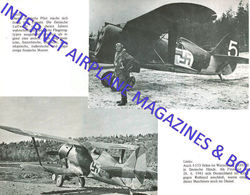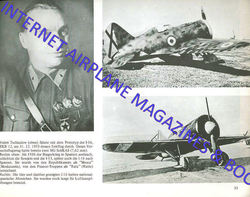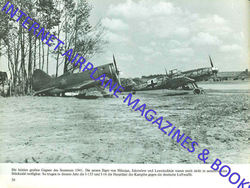STALIN’S RED FALCONS RUSSIAN FIGHTER PLANES 1920-1941 POLIKARPOV I-15
CHATO I-16 RATA WW2
SOFTBOUND BOOK
WRITTEN IN GERMAN “RUSSISCHE JAGDFLUGZEUGE 1920-1941 STALINS ROTE FALKEN”
I-5 SERIES FIGHTER
AIRCRAFT (PROTOTYPE & PRODUCTION AIRCRAFT)
I-15 (SPANISH
CIVIL WAR)
I-152 (I-15bis)
BIPLANE FIGHTER
PV-1 MACHINE GUN
I-153 CHAIKA
BIPLANE FIGHTER
I-16 RATA (SPANISH
CIVIL WAR REPUBLICAN AIR FORCE / AIRCRAFT CAPTURED BY NATIONALIST FORCES)
TsKB-12
AND TsKB-12bis PROTOTYPES
I-16
TYPE 4
TsKB-18
ZVENO
I-16 TYPE 4
I-16
TYPE 5
GROUND
ATTACK I-16 TYPE 5
TsKB-29
I-16P
(CANNON)
ZVENO
I-16 TYPE 5 PARASITE FIGHTER
SPANISH
I-16 TYPE 5s MOSCA SPANISH REPUBLICAN AIR FORCE / SPANISH CIVIL WAR
CHINESE
I-16 TYPE 5
I-16
TYPE 6
FINNISH
I-16 TYPE 6
I-16
TYPE 10
TsKB-12P
I-16TK
I-16
TYPE 18
I-16
TYPE 20
I-16
TYPE 24
I-16
TYPE 27
I-16
TYPE 29
ROMANIAN
AIR FORCE I-16 TYPE 29
SPANISH
MODIFICATIONS
FUSELAGE
DEVELOPMENT
ENGINE
COWLING CHANGES
SKI
LANDING GEAR
GUNSIGHT
CANOPY
WING
ARMAMENT
TWO-SEAT TRAINERS UTI-2 & UTI-4 (GERMAN LUFTWAFFE,
POLISH AIR FORCE, FINNISH, CHINESE)
I-16 TYPE 5
I-16 TYPE 10
M-25 ENGINE
SPECIFICATIONS
M-62 ENGINE
SPECIFICATIONS
M-63 ENGINE
SPECIFICATIONS
ShKAS WING MOUNTED
7.62 MACHINE GUN
I-16 TYPE 24
DETAILS (ENGINE, COWLING, MAIN LANDING GEAR, SPADE GRIP CONTROL STICK,
GUNSIGHT, CANOPY, INSTRUMENT PANEL, RUDDER PEDALS)
I-17
I-180 SERIES 2
WITH M87B ENGINE
M-88 ENGINE
TECHNICAL FEATURES
I-185
TECHNICAL FEATURES
OF TH EM-82A ENGINE
20mm ShVAK CANNON
ITM M-1 AIRCRAFT
WITH M-107P ENGINE INSTALLATION
------------------------------------------------------------------------------------------------------------------
Additional Information from
Internet Encyclopedia
The Polikarpov I-16 was a Soviet fighter aircraft of revolutionary
design. It was the world's first low-wing cantilever monoplane fighter with
retractable landing gear to have attained operational status and as such
"introduced a new vogue in fighter design." The I-16 was introduced
in the mid-1930s and formed the backbone of the Soviet Air Force at the
beginning of World War II. The diminutive fighter, nicknamed "Ishak"
("Donkey") by Soviet pilots, prominently featured in the Second
Sino-Japanese War, the Battle of Khalkhin Gol and the Spanish Civil War—where
it was called the Rata ("Rat") by the Nationalists or Mosca
("Fly") by the Republicans. The Finnish nickname for I-16 was Siipiorava
("Flying Squirrel").
While working on the
Polikarpov I-15 biplane, Nikolai Nikolaevich Polikarpov began designing an
advanced monoplane fighter. It featured cutting-edge innovations such as
retractable landing gear and a fully enclosed cockpit, and was optimized for
speed with a short stubby fuselage (similar to the Gee Bee R-1) and a Wright
Cyclone radial engine in a NACA cowling. The aircraft was small, light and
simple to build.
Full scale work on the TsKB-12 prototype began in June 1933
and the aircraft was accepted into production on 22 November 1933, a month
before it took to the air. The TsKB-12 was of mixed construction using a wooden
monocoque fuselage and wings based around a KhMA chrome-molybdenum steel alloy
wing spar, dural ribs and D1 aluminum alloy skinning on the center and leading
edges, with the remaining portions of the wings fabric covered. Another modern
feature were the ailerons which ran almost the entire trailing edge of the wing
and also operated as flaps (in the manner of more modern flaperons) by drooping
15°. The cockpit was covered by a forty cm (sixteen in) wide canopy
which featured an Aldis tubular gun sight which could slide back and forth on
runners fitted with rubber bungee cords. A 225 l (59.4 US gal) fuel
tank was fitted directly in front of the cockpit. The main landing gear was
fully retractable by a hand-crank. The armament consisted of a pair of
7.62 mm (0.30 in) ShKAS machine guns in the wings, mounted on the
outboard side of the main gear and 900 rounds of ammunition
At the start of Spanish Civil
War in 1936, Republican forces pleaded for fighter aircraft. After receiving
payment in gold, Joseph Stalin dispatched around 475 I-16 Type 5s and Type 6s.
The first I-16s appeared in Spanish skies in November 1936. The Polikarpov
monoplanes had their baptism of fire on 13 November 1936, when twelve I-16s
intercepted a Nationalist bombing raid on Madrid. Soviet pilots claimed four
air victories and two German Heinkel He 51 pilots were killed. But the Soviets
suffered losses too; the group commander collided with an enemy aircraft and
another I-16 pilot crash landed. The Polikarpovs immediately began dominating
the enemy He 51s, Arado Ar 68 and Fiat CR.32 biplanes and remained unchallenged
until the introduction of the Messerschmitt Bf 109. The arrival of the newest
Bf 109Bs and the overwhelming numerical superiority of Nationalist fighters
were the primary cause of the heavy I-15 and I-16 combat losses suffered by
throughout 1937. A number of aviation publications called the new Soviet
fighter a "Boeing" due to the incorrect assumption that it was based
on the Boeing P-26's design. The Nationalists nicknamed the stubby fighter Rata (Rat), while the Republicans
affectionately called it Mosca
(Fly).
Combat experience showed that
the I-16 had deficiencies; several aircraft were lost after structural failure
of the wings which was quickly remedied by reinforced structures. Heavy machine
gun bullets could sometimes penetrate the armored backrest and fuel tanks occasionally
caught fire in spite of being protected. The hot Spanish summers required the
addition of oil radiators, and dust adversely affected the life of the engines.
Although some aircraft accumulated up to 400 hours of flying time, the average
life of an I-16 was 87 days, of which one sixth was spent on maintenance. The
biggest complaint in service was the light armament of only two 7.62 mm
(0.30 in) machine guns. This was urgently addressed with the Type 6 which added a third ShKAS in
the bottom of the fuselage. The four-gun Type 10 was nicknamed "Super Mosca" or simply
"Super". The total number of I-16s delivered to Spain from 1936 to
1938 amounted to 276. When the war ended on 1 April, 1939, 187 Ratas had been lost in Spain: 112
lost in combat, one shot down by anti-aircraft fire, eleven destroyed on the
ground, one force-landed and 62 lost in accidents
Another 250 I-16 Type 10s were supplied to China.
This model added a second set of 7.62 mm (0.30 in) ShKAS machine
guns, armor behind the pilot, and had a slightly upgraded 560 kW
(750 hp) M-25 engine. In 1939, of the 500 I-16s deployed to the fighting
at Nomonhan, approximately 112 were lost during the battles of Khalkhin Gol, of
which 88 were destroyed in aerial combat, primarily against the all metal Ki-27
IJA fighters. During test trials in Russia of a captured Ki-27, the aircraft
proved superior to the Soviet I-152 (I-15bis), I-153, and the I-16 in aerial
combat, as well as having a faster take off and lower landing speed requiring
shorter airstrips than the I-16, which needed 270 meters to stop and 380 meters
for take off.
Further attempts were made to
upgrade the firepower of the aircraft using twenty mm (0.79 in) ShVAK
cannons, making the I-16 one of the most heavily armed fighters of the period,
able to fire 28 pounds of ammunition in three seconds. Pilots loved the
results, but the cannons were in short supply and only a small number of the I-16 Type 12, 17, 27, and 28 were built. The cannons adversely
affected performance with 360° turn time increasing from fifteen seconds in the
Type 5 to eighteen seconds. The Type 24
replaced the skid with a tailwheel and featured the much more powerful
670 kW (900 hp) Shvetsov M-63 engine. The Type 29 replaced two of the ShKAS guns with a single 12.7 mm
(.50 in) UBS. Types 18, 24, 27, 28, and 29 could be fitted to carry RS-82
unguided rockets
The pilots nicknamed the
aircraft Ishak (Russian: Èøàê, Donkey/Hinny)
because it was similar to the Russian pronunciation of "I-16". When
Operation Barbarossa erupted on 22 June 1941, 1,635 of 4,226 VVS aircraft were
I-16s of all variants, fielded by 57 fighter regiments in frontier areas.
TsKB-12: First prototype, M-22
engine, 336 kW (450 hp), two unsynchronized ShKAS machine guns in the
wings with 900 rpg.
TsKB-12bis: Second prototype, Wright
SGR-1820-F-3 Cyclone engine, 533 kW (715 hp)
TsKB-12P (I-16P): Prototype armed with two
ShVAK cannon in the wings, 150 rpg.
TsKB-18: Ground attack prototype
with M-22 engine and armored cockpit. Armed with four ShKAS or PV-1 machine
guns and 100 kg (220 lb) of bombs. Two additional Type 5s were fitted
with six ShKAS machine guns of which four could decline to 20° for ground
strafing.
TsKB-29 (SPB): Pneumatically-operated
landing gear and flaps, Wright Cyclone engine, armament of two ShKAS machine
guns, used as a high-speed dive bomber in the Zveno project
I-16 Type 1: Pre-production series, M-22
engine with 358 kW (480 hp).
I-16 Type 4: First production version,
M-22 engine.
I-16 Type 5: Type 4 with a streamlined
and tapered engine cowling, Shvetsov M-25 engine with 522 kW
(700 hp).
I-16 Type 6: M-25A engine, 545 kW
(730 hp).
I-16 Type 10: Four ShKAS machine guns
(two synchronized in the fuselage and two in the wings), windscreen replaced
the sliding canopy, could be fitted with retractable skis for winter
operations, M-25B engine with 560 kW (750 hp). Hispano-Suiza-built
aircraft were powered by the Wright Cyclone R-1820-F-54 engine.
I-16 Type 17: Type 10 with two ShKAS
machine guns and two ShVAK cannon, rubber tail wheel, M-25V engine with
560 kW (750 hp). Some aircraft were fitted with an additional
12.7 mm (0.5 in) Berezin UB machine gun for strafing.
I-16 Type 18: Type 10 with Shvetsov M-62
engine producing 620 kW (830 hp), with a two-speed supercharger and a
variable-pitch propeller. Capable of carrying two 100 l (26 US gal)
underwing fuel tanks.
I-16 Type 20: Four ShKAS, first version
capable of carrying underwing fuel tanks with 93 l (25 US gal)
capacity based on tanks used on the Japanese Nakajima Ki-27, 80 built.
I-16 Type 24: Four ShKAS, landing flaps
replaced drooping ailerons, tailwheel added, second cockpit door added on the
starboard side, Shvetsov M-63 engine with 670 kW (900 hp).
I-16 Type 27: Type 17 with an M-62
engine.
I-16 Type 28: Type 24 with two ShKAS and
two ShVAK.
I-16 Type 29: Two synchronized ShKAS in the
nose and a single 12.7 mm (0.50 in) UBS in the bottom of the
fuselage, no wing guns. Could carry 4-6 RS-82 rockets.
I-16 Type 30: Re-entered production in
1941-42, M-63 engine.
I-16TK: Type 10 with a
turbocharger for improved high-altitude performance, reached 494 km/h
(307 mph) at 8,600 m ( 28,200 ft), did not enter production.
UTI-1: Two-seat trainer version of
Type 1.
UTI-2: Improved UTI-1 with fixed
landing gear.
UTI-4 (I-16UTI): Two-seat trainer version of
Type 5, most with fixed landing gear.








